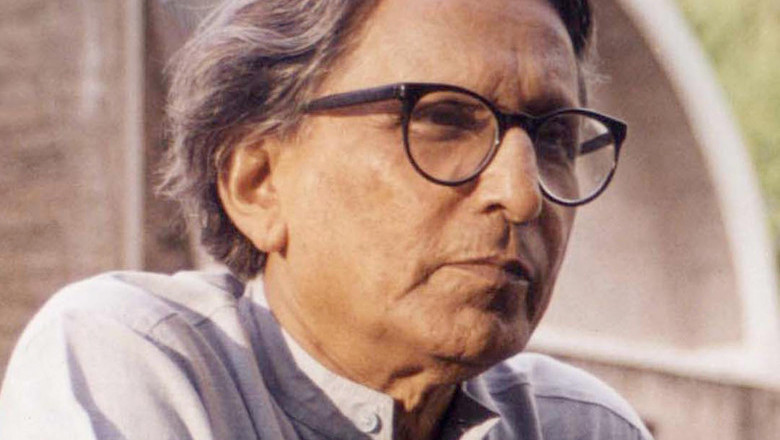views

An architect is someone who builds not buildings but brotherhood. It is because of an Architect that people with different views and perspectives can sit under one roof and communicate and debate or study and relate. Architecture is a profession whose performance could be seen and evaluated regularly as we pass through the streets. But the more important thing, the lesser we acknowledge it, no better example than the ‘nature.’ We value a doctor, a cricketer, an actor, a political leader, a teacher, but the real architects of a country are hardly ever recognized.
For a building, who inaugurates it has become more important than who made it. From this mine of underrated professionals comes a man who has proved his mettle worldwide. Balkrishna Vithaldas Doshi- an Indian architect- won the Pritzker prize, referred to as the Nobel Prize of Architecture, in 2018.
Capturing the Spark
Born in 1927 in Pune, Mr. Doshi’s was an extended Hindu Family whose last two generations were involved in the furniture industry. One of his school teachers recognized his hidden attraction to the Architectural profession, and this marked the beginning for him.

1947, the most important year for any Indian, saw the formal starting of Mr. Doshi’s Architectural career as he got himself enrolled at Sir J.J. School of Architecture in Bombay- the oldest architectural institution in India.
The coming years saw him being ambitious as he went on to take some brave decisions. With a dream to join the Royal Institute of British Architects, he boarded a ship destined to reach London. However, this didn’t work out eventually but to stop dreaming with just one failure was not his cup of tea. At this point, he must have thought:
“Failure will never overtake me if my determination to succeed is strong enough.” ~ Og Mandino
Doshi’s next stop was Paris and that too when he knew nothing about the French language. The objective of moving to Paris was nothing short of a miraculous dream of working under one of the pioneers of Modern Architecture- Le Corbusier. He found success and started working under him and considered him his 'Guru.' He showered gratitude on his Guru when he was given the Pritzker prize, by thanking him for the lessons he taught.
Bigger the Aim, better the name
Doshi wanted to rebuild India in a way which was far better than the one prevalent at that time. Having a profound interest in Indian culture and history, Doshi involved his elements of youth- memories of temples, shrines and busy streets; lacquer and wood scents from the furniture workshop of his grandfather- in his style of architecture. Some people go on to do what they are taught, and some do what they are taught in their way. BV Doshi was injected with lessons from western architects which he innovated upon to further improve his artistic vision including celebrating life, forces of nature, and eastern culture. These were enough for him to create a personal architecture garnished with sounds, sights, and memories from his past.

He wanted people to feel a connection every time they entered a building, and that connection could be due to the positive vibes created by a heart touching architectural design.
Barack Obama once said, “We did not come here to fear the future. We came here to shape it.” it goes perfectly with Doshi as well.
'Building' Changes
Social change is the slowest to happen but the most important. We would be unfair to Doshi if we expect him to revolutionize the society, but he did all that he could. Doshi always wanted his architecture to be for India, and his collection of work give us clues about the type of settings most of us would want to live in. Buildings with plenty of traditional patterns of living have been designed and constructed by Doshi to attract the user towards mindful collusion with space and not to the needs of an office or a house, a school or factory. The weapons in his armory- material, texture, light, planning, and assembly- and his ability to sense the right design helped him achieve his targets.
The story wasn't over yet
When Doshi returned to India in 1954, he went on to oversee the projects of Le Corbusier in Ahmedabad and Chandigarh which included the Shodhan House and Mill Owners’ Association Building among others. In 1956, he went on to hire two architects and founded Vastushilpa(now Vastushilpa Consultants), his practice, which has completed projects more than 100 in number since its establishment. It was in 1962 when he began working as an associate with Louis Kahn to construct the Indian Institute of Management, Ahmedabad. Their epic collaboration lasted for more than a decade.
“It is not the beauty of a building you should look at; its the construction of the foundation that will stand the test of time.”- David Allan Coe.
Though he created many institutions, multi-purpose complexes, galleries, housing projects, private residences and public spaces, Sangath-his architecture studio- remains one of his favorites. A place to learn, unlearn and relearn, Sangath is a school which has become a sanctuary of art, culture, and sustainability. Indeed, his life has been a box full of inspiring events which infuse energy into the modern generation.

The Endless list of Achievements
In 1976, he was honored with the Padma Shri award. And, apart from receiving the Pritzker Prize, Doshi also has many other accomplishments against his name. In 2017, a collection of his works “Celebrating Habitat: The real, the virtual and the Imaginary” traveled to Shanghai three years after it opened at the National Gallery of Modern Arts, Delhi. He recently delivered a lecture at the Royal Academy of Arts, London, UK. These are just a few of his numerous accomplishments due to his exemplary work in the field of Architecture.
Conclusion
Born in the pre-independence era, Doshi’s success proves that the situation may be tough, but if you have the guts to take the right risks in your life, you’ll surely be rewarded. His excellence in his field is the result of the continued hard work he put in throughout the journey of ups and downs. Doshi lived with the goal of preserving the Indian Culture through his work.












